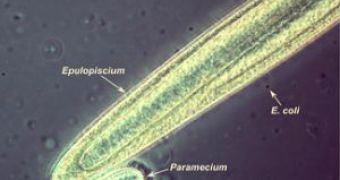This is like the blue whale of the bacterial world. Epulopiscium is as big as a mountain when compared to other bacteria, having the size of a grain of salt and being a million times larger than the common E. coli bacteria: you can see it with the naked eye. A new study carried out at Cornell and published in the Proceedings of the National Academy of Sciences journal has unveiled the secret of this gigantism: it consists in the ability of the bacterium to copy its DNA up to 85,000 times. This bacterium has a DNA amount 25 times higher than the one found in a human cell.
The Epulopiscium bacterium is a cigar-shaped symbiontic organism inhabiting the gut of surgeonfish, a tropical reef fish genus.
"Other bacteria have multiple copies of their genome, but prior to this, I think the highest numbers known have been a hundred or a few hundred copies. The big discovery is seeing this bacterium with tens of thousands of copies of its genome," said senior author Esther Angert, a Cornell associate professor of microbiology.
Common bacteria are small and very simple, devoid of organelles that enable eukaryotic cells (with DNA wrapped in a nucleus, like in plants, animals and fungi) to have complex cellular functions and to grow larger. Bacteria feed via diffusion through their cell membranes, and as they cannot transport actively nutrients within the cell, they are forced to remain small in order for the diffusion to function.
"But, by copying its genome thousands of times and arraying it in a kind of fabric just under the cell membrane, Epulopiscium sp. may maintain its large size by keeping its DNA close to the outer surface," Angert explained. This way, the genes on the DNA react rapidly to local stimuli, triggering the synthesis of the necessary proteins.
"Having copies of its genome arrayed around the periphery keeps the DNA close to the outer environment. The bacterium can immediately react as something comes in contact with the cell," Angert added. Despite being so large, this bacterium is also highly mobile and escapes from the attacks of most protozoan predators also found in the surgeonfish's gut. Most bacteria just divide into two offspring of the same size, but Epulopiscium grows two internal offspring cells, one at each pole, which are then released when the mother cell eventually dies and tears down.
The largest bacteria
Bacteria are the smallest cell organisms. Only viruses are smaller than a bacterium. Common bacteria are about 10 times smaller than eukaryotic cells, being typically 0.5-5.0 micrometers long (you need a microscope to see them). Thousands of bacteria are found in a droplet of saliva, representing tens of species. With each inhalation, other thousands of bacteria reach our respiratory tract. There are typically 40 million bacterial cells in a gram of soil and a million bacterial cells in a milliliter of fresh water; in all, there are approximately five nonillion (5?1030) bacteria in the world. Indeed, they are the most common life form on Earth, living in the most extreme conditions, from the bottom of the oceans and submarine hot vents to thermal springs.
With all that, the Epulopiscium fishelsoni, which reaches a length of 0.7 mm (being thus 150 times bigger than larger bacteria) is the size of many small insects and crustaceans. Epulopiscium was discovered in 1985.
In 1999, an even larger bacterium was found, Thiomargarita namibiensis, with a width of up to 0.75 mm. The bacteria uses nitrates to synthesize organic chemicals. The species was first discovered off the coast of Namibia but, in 2005, a closely related species was also discovered in a Gulf of Mexico cold seep.

 14 DAY TRIAL //
14 DAY TRIAL //